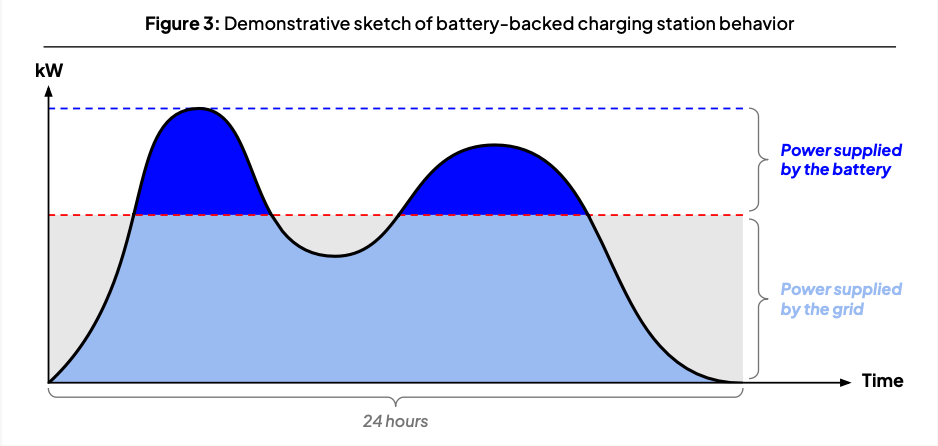Utility demand charges are a critical component of EV fast charging station economics, contributing significantly to operating expenses. For many retailers, demand charges can be the difference between building a station or not. Battery-backed EV charging stations, however, present a solution by mitigating high demand charges and changing the station economics.
The Basics: Utility Demand Charges
Utility demand charges are fees levied by electric utilities on commercial and industrial customers based on their peak electricity demand during a given billing period.
These charges are designed to recover the costs associated with providing sufficient electrical infrastructure to meet peak demand. For EV fast charging stations, which can draw significant amounts of power (measured in kW or MW) in short bursts, demand charges can represent a substantial portion of station owner operating expenses, as even short periods of high charging activity can set a high demand level that the utility charges for across the entirety of any given billing cycle ($/kW).
Battery-backed vs. Grid-connected stations
Traditional grid-connected fast charging stations draw power directly from the grid, which utilities manage. While this is a straightforward approach, it leaves charging stations and their operators vulnerable to high demand charges. Battery-backed stations, on the other hand, incorporate energy storage systems (BESS) as a wedge between chargers and the grid to help reduce these charges (while offering several other benefits). Battery-backed stations operate by:
- Charging the BESS during off-peak hours when electricity rates are cheaper and station charging demand is lower (as much as possible)
- Discharging the BESS later when charging demand rises, which often coincides with periods of peak electricity demand and higher electricity costs on the grid. The BESS may not always fully satisfy charging demand, but at minimum, can supplement grid power draw, reducing the peak kW drawn from the utility-managed grid.
Read our whitepaper: Utility service & battery sizing for storage backed EV fast charging stations
This strategy is known as "peak shaving" and allows battery-backed stations to reduce demand charges significantly. This reduces opex costs for station operators, improves overall station profitability, and often increases reliability, too.

Station Design Principles
Electric Era employs a utilization-based charging station model to draw quantitative conclusions about the sizing of the grid connection required for any charging station. The essential inputs to this model are:
- Vehicle charging temporal distribution (EVSession data)
- Fleet composition (Kelly Blue Book EV sales, latest report here)
- Vehicle charging curves
- Vehicle energy request distribution (Electrify America Annual Reports, National, California)
- Port count and max per port power.
While the intricacies of our model and these inputs are best saved for another white paper, at a high level, Electric Era designs our stations to meet the instantaneous demand of charging vehicles for more than 95% of sessions without capping or limiting vehicle power. For a 4-charger station, our analysis indicates that 100% saturation occurs at 250 sessions per day, and 50% utilization occurs at 125 sessions. Modeling station utilization is critical to understanding and planning for expected operating costs.
Case Study: National Fuel Retailer
Let's illustrate the potential impact of peak shaving and proper opex modeling with a real example: Imagine a national fuel retailer/c-store conglomerate with 1,200+ locations wants to build an EV charging station at a site in the Northeast USA with four 200 kW chargers. The electricity rate available from the utility includes a high demand charge of $31.42/kW and a low energy cost of $0.15/kWh. This makes the site a good candidate for adding a BESS. Let’s evaluate the difference in monthly electricity costs for a grid-connected versus a battery-backed station operating in this utility service territory:
Both stations will have a grid connection, but will differ in needed transformer size (kVA).
Grid-only approach: The grid-connected station can be sized to meet nameplate hardware power of 4x200 kW by using an 800+ kVA transformer. This adds extra capex cost and can introduce deployment delays given the length of utility interconnection queues and long transformer lead times. It can still make sense if the station must hit a certain power threshold. Otherwise, some grid-connected providers choose to “oversubscribe” their stations, choosing a smaller transformer (e.g., a 600 kVA transformer) to meet 95% or more of customer demand but sacrificing charging speed during peak events.
Battery-backed approach: The battery-backed station can leverage a much smaller transformer size because it will use power from its BESS (379 kWh capacity, 250 kW inverters) in addition to oversubscribing (as discussed above). In our experience operating sites and conducting simulation analysis, we set typical transformer size at 300 kVA (see the below figure of simulated daily power demand for a 4-charger station operating at 50% utilization)

Now, let’s compare the grid-connection station and battery-backed station operating across low, medium, and high utilization scenarios to compare the cost of demand charges. For all scenarios, we assume 35 kWh of energy delivered per session and 6% more energy used by the battery-backed station due to round trip efficiency losses inherent to the BESS.
In the low utilization scenario, we assume no more than 2 concurrent 200 kW sessions. In the high utilization scenario, we assume no more than 3 concurrent 200 kW sessions. The battery-backed station can set a lower grid power limit than the grid-connected station and still provide the same level of service to customers by supplementing grid power with battery power.
Low Utilization - 10 sessions per day

High Utilization - 50 sessions per day

10-year timeframe results:

Conclusion: In the high utilization scenario, operating a grid-connected station will cost 50% more (over $1M) than a battery-backed station. With low utilization, a grid-connected station will face more than $700K in additional demand charges, a 95% increase in utility costs compared to a BESS station.
Additional Benefits of Battery-Backed Stations
Beyond reducing demand charges, battery-backed stations offer several other advantages:
- Faster deployment: By using a smaller grid connection, battery-backed stations offer shorter lead times to procure and install utility transformers, speeding up how quickly new stations get built and launched.
- Greater stability: By reducing peak kW demand, battery-backed stations can help stabilize the grid and minimize strain on utility infrastructure while still serving charging customers seamlessly.
- Enhanced resilience: Battery-backed stations can provide backup power during grid outages, ensuring continued operation and enhancing customer satisfaction.
- Valorizing renewable energy: Battery-backed stations are ideal candidates for pairing with solar and other renewable sources to further reduce reliance on the grid, promote sustainability, and reduce renewable energy curtailment.
Battery-Backed EV Charging: reduces OpEx, increases profitability
As demand for EV charging infrastructure continues to grow, battery-backed solutions like Electric Era offer a compelling approach to mitigate the financial burden of utility demand charges. By managing energy consumption strategically and reducing peak demand, battery-backed stations can improve station owner profitability, saving money while maintaining a high bar for customer experience. The addition of a BESS also improves station and grid reliability, delivering high-powered charging sessions when consumers need them while reducing total peak power.
Explore how Electric Era has helped retailers drive business value with EV fast charging